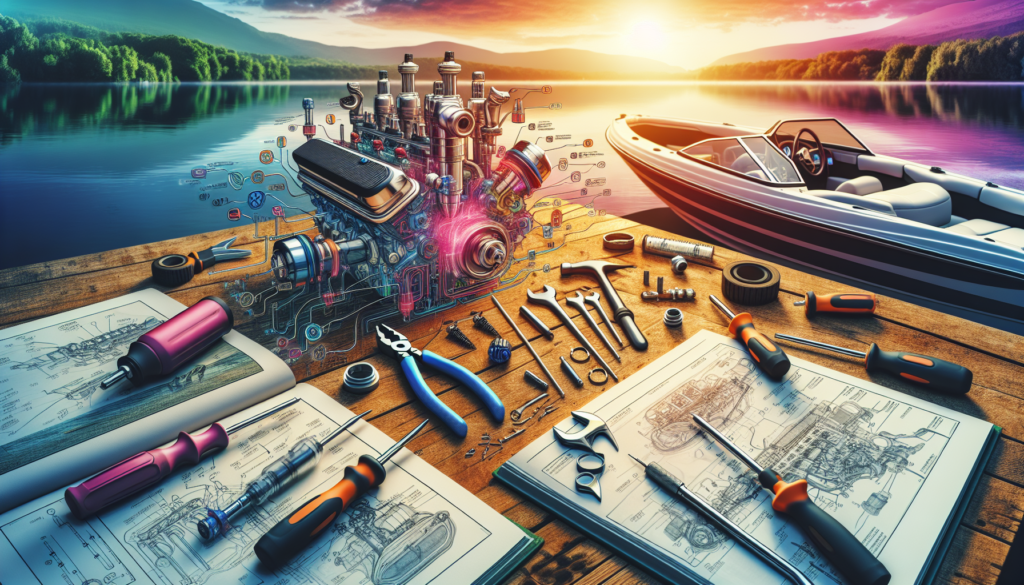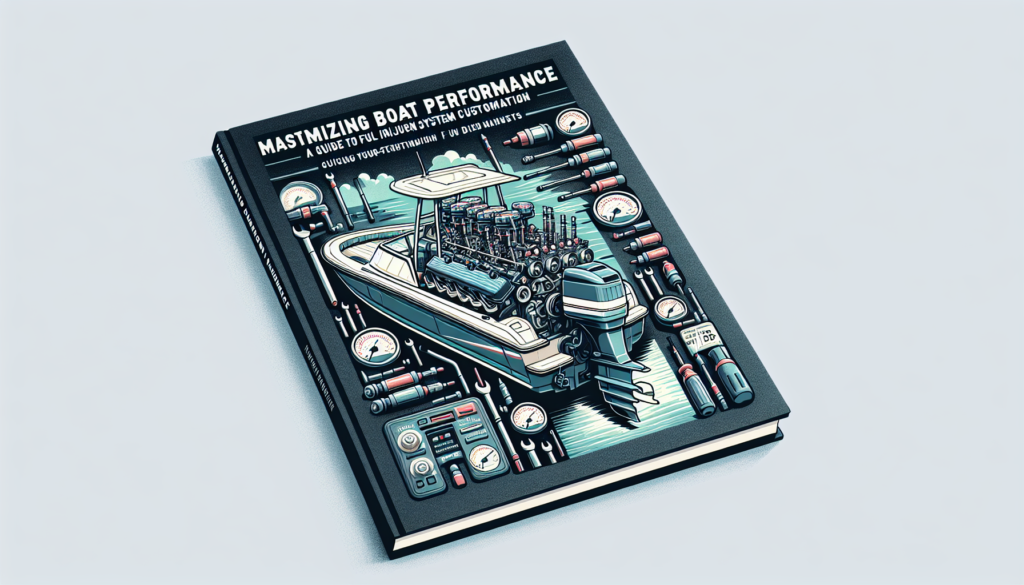If you’re a boat owner and looking to enhance your vessel’s performance, then this DIY guide is for you. In this article, we will take you through the step-by-step process of customizing your boat’s fuel injection system. With our easy-to-follow instructions and helpful tips, you’ll be able to optimize your boat’s engine performance and maximize fuel efficiency. Whether you’re a seasoned boater or just starting out, this guide will equip you with the knowledge and confidence to take control of your boat’s fuel injection system customization. Upgrade your boat’s performance today!

Choosing the Right Fuel Injection System
Understanding the Different Types of Fuel Injection Systems
When it comes to customizing your boat’s fuel injection system, it’s important to have a clear understanding of the different types of fuel injection systems available. The two main types are port fuel injection (PFI) and direct fuel injection (DFI).
In port fuel injection, the fuel is injected into the intake manifold, where it mixes with the incoming air before entering the combustion chamber. This type of system is commonly found in older boat engines and is known for its simplicity and reliability.
On the other hand, direct fuel injection systems inject fuel directly into the combustion chamber. This allows for a more precise control of the fuel-air mixture, resulting in better fuel efficiency and increased power. DFI systems are typically found in more modern boat engines.
Considering Your Boat’s Engine Requirements
Once you have a basic understanding of the different types of fuel injection systems, it’s important to consider your boat’s specific engine requirements. Factors such as engine size, horsepower, and intended use of the boat will all play a role in determining the appropriate fuel injection system for your needs.
For example, if you have a high-performance boat with a powerful engine, you may want to consider a direct fuel injection system. These systems offer better fuel efficiency and increased power, making them ideal for high-performance applications. On the other hand, if you have a smaller boat with a less powerful engine, a port fuel injection system may be more than sufficient.
Researching and Comparing Fuel Injection Systems
Once you have a clear understanding of your boat’s engine requirements, it’s time to start researching and comparing different fuel injection systems. Look for reputable manufacturers that offer high-quality products and have a good track record in the industry.
Consider factors such as system compatibility with your boat’s engine, ease of installation, and overall performance. Read reviews from other boat owners who have installed the systems you are considering to get an idea of their experiences and satisfaction levels.
Reach out to reputable marine mechanics or fuel injection specialists for their recommendations and advice. They can offer insights based on their expertise and experience working with various fuel injection systems.
Preparing for the Customization Process
Gathering the Necessary Tools and Equipment
Before you begin customizing your boat’s fuel injection system, it’s important to have all the necessary tools and equipment on hand. This will ensure a smooth and efficient customization process.
Some of the tools and equipment you may need include wrenches, screwdrivers, a fuel pressure gauge, fuel line disconnect tools, a fuel injector cleaning kit, and a fuel line removal tool. It’s also a good idea to have a clean and well-organized workspace to make the process easier and more enjoyable.
Removing Existing Fuel Injection Components
Once you have gathered all the necessary tools and equipment, it’s time to remove the existing fuel injection components from your boat’s engine. Start by disconnecting the battery to ensure your safety during the process.
Carefully remove the fuel injectors, fuel rails, fuel pump, fuel pressure regulator, fuel filters, and fuel lines. Follow the manufacturer’s guidelines and use the appropriate tools to prevent any damage to the components or your boat’s engine.
Inspecting and Cleaning the Fuel Injection System
With the existing fuel injection components removed, take some time to inspect and clean each component thoroughly. Check for any signs of damage or wear and replace any parts that are not functioning properly.
Use a fuel injector cleaning kit to remove any debris or deposits that may have built up over time. This will help ensure that your new fuel injection system operates at its optimal performance level.
Inspect the fuel rails, fuel pump, fuel pressure regulator, fuel filters, and fuel lines for any signs of damage or wear. Replace any components that show signs of deterioration to prevent any potential issues in the future.

Customizing Fuel Injectors
Understanding the Function and Importance of Fuel Injectors
Fuel injectors play a crucial role in delivering the right amount of fuel into the combustion chamber of your boat’s engine. They are responsible for atomizing the fuel, ensuring that it mixes thoroughly with the incoming air before combustion occurs.
Upgrading your fuel injectors can result in improved fuel atomization, better fuel efficiency, increased power, and smoother engine performance. It’s important to choose the right size and flow rate for your specific engine requirements to achieve optimal results.
Calculating the Ideal Flow Rate for Your Boat
Calculating the ideal flow rate for your boat’s fuel injectors is essential to ensure that your engine receives the appropriate amount of fuel for its power output. The flow rate is typically measured in pounds per hour (lb/hr) and can be determined by considering factors such as engine displacement, horsepower, and desired operating conditions.
Consulting with a marine mechanic or fuel injection specialist can help you determine the ideal flow rate for your boat’s engine. They can take into account factors such as engine modifications, intended use of the boat, and any future performance enhancements.
Upgrading to High-Performance Fuel Injectors
Once you have determined the ideal flow rate for your boat’s fuel injectors, you can begin considering the different options available. Upgrading to high-performance fuel injectors can offer several benefits, including increased fuel efficiency and power output.
High-performance fuel injectors are designed to deliver a precise amount of fuel at higher pressures, resulting in improved atomization and combustion. This leads to better throttle response, increased power, and smoother engine operation.
Replacing and Installing Fuel Injectors
Once you have chosen the appropriate high-performance fuel injectors for your boat’s engine, it’s time to replace and install them. Begin by removing the old fuel injectors and carefully installing the new ones.
Follow the manufacturer’s guidelines and use the appropriate tools to ensure a proper installation. Pay attention to the torque specifications and be careful not to overtighten or cross-thread the injector fittings.
Once the new fuel injectors are installed, make sure to test and verify their functionality before moving on to the next step in the customization process.
Upgrading the Fuel Rails
Understanding the Purpose and Benefits of Fuel Rails
Fuel rails, also known as fuel manifolds, are an essential component of the fuel injection system. They act as a conduit for delivering fuel from the fuel injectors to the engine’s cylinders.
Upgrading your fuel rails can result in improved fuel flow, enhanced fuel atomization, and better overall engine performance. The increased fuel flow provided by upgraded fuel rails can support higher horsepower levels and ensure a consistent fuel supply throughout the engine.
Choosing Between Traditional and High-Flow Fuel Rails
When considering upgrading your fuel rails, you have the option to choose between traditional fuel rails and high-flow fuel rails. Traditional fuel rails are designed to meet the fuel flow requirements of a stock engine, while high-flow fuel rails offer increased fuel flow capacity.
If you have an engine that has been modified for higher performance or if you plan to make future modifications, high-flow fuel rails may be a better choice. They can handle the increased fuel demands that come with higher horsepower levels, ensuring optimal engine performance.
Considering Fuel Pressure and Sizing Options
When selecting fuel rails for your boat’s engine, it’s important to consider both fuel pressure and sizing options. The fuel pressure rating of the fuel rails should match the requirements of your specific engine.
Sizing options refer to the physical dimensions of the fuel rails and their compatibility with your boat’s engine. Make sure to measure your existing fuel rails or consult the manufacturer’s specifications to ensure a proper fit and avoid any clearance issues.
Installing Upgraded Fuel Rails
Once you have chosen the appropriate fuel rails for your boat’s engine, it’s time to install them. Begin by removing the old fuel rails carefully, making sure to disconnect any fuel lines or electrical connections.
Install the new fuel rails following the manufacturer’s guidelines, using the appropriate tools and torque specifications. Take your time to ensure a proper and secure installation.
It’s important to verify the functionality of the upgraded fuel rails before proceeding with the customization process.

Modifying the Fuel Pump
Understanding the Functionality of the Fuel Pump
The fuel pump plays a vital role in delivering fuel from the fuel tank to the fuel injection system. It is responsible for maintaining the required fuel pressure and ensuring a consistent flow of fuel to the engine.
Modifying your fuel pump can result in improved fuel delivery and increased power output. Upgrading to a higher-performance fuel pump can support higher horsepower levels and ensure optimal engine performance.
Determining the Proper Fuel Pump Size and Pressure
When modifying your fuel pump, it’s crucial to determine the proper size and pressure for your specific engine requirements. The size of the fuel pump should be selected based on factors such as engine size, horsepower, and intended use of the boat.
Fuel pump pressure refers to the amount of pressure required to deliver fuel to the fuel injection system. Determining the proper fuel pump pressure depends on factors such as engine modifications, desired performance levels, and the fuel injection system being used.
Consulting with a marine mechanic or fuel injection specialist can help you determine the proper fuel pump size and pressure for your boat’s engine.
Choosing Between Mechanical and Electric Fuel Pumps
When upgrading your fuel pump, you have the option to choose between mechanical and electric fuel pumps. Mechanical fuel pumps are driven by the engine’s camshaft and provide a consistent flow of fuel, while electric fuel pumps are powered by electricity.
Consider factors such as engine requirements, fuel demand, ease of installation, and overall performance when choosing between mechanical and electric fuel pumps. Electric fuel pumps are generally more commonly used in high-performance applications due to their higher flow rates and ability to handle increased fuel demands.
Upgrading and Installing the Fuel Pump
Once you have determined the proper size, pressure, and type of fuel pump for your boat’s engine, it’s time to upgrade and install it. Begin by disconnecting the battery and removing the old fuel pump carefully.
Follow the manufacturer’s guidelines and use the appropriate tools to ensure a proper installation. Pay attention to the electrical connections and ensure they are secure and properly grounded.
After installing the new fuel pump, it’s important to test and verify its functionality before proceeding with the customization process.
Installing a Fuel Pressure Regulator
Understanding the Role of the Fuel Pressure Regulator
The fuel pressure regulator is responsible for maintaining a constant fuel pressure within the fuel injection system. It ensures that the fuel injectors receive the proper amount of fuel at all times, regardless of changes in fuel demand or engine load.
Installing a fuel pressure regulator can result in improved fuel efficiency, increased power output, and better overall engine performance. It helps prevent fuel pressure fluctuations that can negatively impact engine operation.
Determining the Optimal Fuel Pressure for Your Engine
Determining the optimal fuel pressure for your boat’s engine is essential to achieve optimal performance and efficiency. The fuel pressure requirements depend on factors such as engine size, horsepower, and the fuel injection system being used.
Consulting with a marine mechanic or fuel injection specialist can help you determine the optimal fuel pressure for your specific engine requirements. They can take into account factors such as engine modifications, desired performance levels, and the compatibility of the fuel injection system being used.
Choosing Between Adjustable and Non-Adjustable Regulators
When selecting a fuel pressure regulator for your boat’s engine, you have the option to choose between adjustable and non-adjustable regulators. Adjustable regulators allow for fine-tuning of the fuel pressure, while non-adjustable regulators maintain a constant fuel pressure.
Consider factors such as your engine’s requirements, desired control over fuel pressure, and your level of comfort with tuning when choosing between adjustable and non-adjustable regulators.
Installing and Calibrating the Fuel Pressure Regulator
Once you have chosen the appropriate fuel pressure regulator for your boat’s engine, it’s time to install and calibrate it. Begin by removing the old fuel pressure regulator and carefully installing the new one.
Follow the manufacturer’s guidelines and use the appropriate tools to ensure a proper installation. Make sure to properly connect the fuel lines and electrical connections, paying attention to any recommended torque specifications.
Calibrating the fuel pressure regulator will typically involve adjusting the regulator to achieve the desired fuel pressure. Follow the manufacturer’s instructions or consult with a professional to ensure accurate calibration.

Upgrading the Fuel Filters
Understanding the Importance of Fuel Filters
Fuel filters play a critical role in maintaining the cleanliness and integrity of the fuel entering your boat’s engine. They help prevent contaminants such as dirt, water, and debris from reaching the fuel injectors, which can cause damage and negatively impact engine performance.
Upgrading your fuel filters can result in improved fuel quality, increased fuel efficiency, and better overall engine performance. It’s important to choose the right type and micron rating of fuel filters for your specific engine requirements.
Choosing the Right Type and Micron Rating of Fuel Filters
When selecting fuel filters for your boat’s engine, it’s important to choose the right type and micron rating. The type of fuel filter refers to its filtration method, with the two main types being inline fuel filters and canister fuel filters.
Inline fuel filters are typically placed in the fuel line and offer a simple and compact design. Canister fuel filters are usually larger and offer higher filtration capacity. The choice between the two types depends on factors such as available space and filtration requirements.
The micron rating of a fuel filter refers to the size of the particles it can effectively filter out. The lower the micron rating, the finer the filtration. Consider factors such as fuel quality, engine requirements, and intended use of the boat when determining the appropriate micron rating for your fuel filters.
Upgrading to High-Performance Fuel Filters
Upgrading to high-performance fuel filters can offer additional benefits beyond basic filtration. High-performance fuel filters are designed to provide superior filtration capacity and increased flow rates, ensuring optimal fuel delivery to the engine.
These filters can handle higher horsepower levels, support better fuel atomization, and improve overall engine performance. Consider upgrading to high-performance fuel filters if you have a high-performance boat or plan to make future modifications.
Replacing and Installing Fuel Filters
Once you have chosen the appropriate fuel filters for your boat’s engine, it’s time to replace and install them. Begin by locating the existing fuel filters and carefully removing them.
Follow the manufacturer’s guidelines and use the appropriate tools to ensure a proper installation. Pay attention to the fuel flow direction indicated on the filters, making sure to install them correctly.
After installing the new fuel filters, it’s important to verify their proper functionality and ensure that there are no fuel leaks before proceeding with the customization process.
Upgrading the Fuel Lines
Understanding the Purpose and Benefits of Proper Fuel Lines
Fuel lines play a critical role in delivering fuel from the fuel tank to the fuel injection system. Proper fuel lines are essential for ensuring a consistent and reliable fuel supply to your boat’s engine.
Upgrading your fuel lines can result in improved fuel flow, increased durability, and better overall engine performance. It’s important to choose the right material and size for your fuel lines to ensure optimal fuel delivery.
Choosing the Right Material and Size for Fuel Lines
When selecting fuel lines for your boat’s engine, it’s important to consider both the material and size. The material of the fuel lines should be compatible with the type of fuel being used and resistant to degradation caused by fuel additives or biofuels.
Common fuel line materials include stainless steel braided hoses, synthetic rubber hoses, and high-density polyethylene (HDPE) tubing. Choose a material that meets the requirements of your specific engine and fuel type.
The size of the fuel lines refers to their internal diameter and should be chosen based on factors such as engine requirements, fuel demand, and desired performance levels. Consult with a marine mechanic or fuel injection specialist to determine the appropriate fuel line size for your boat’s engine.
Replacing Old or Damaged Fuel Lines
If your boat’s existing fuel lines are old or damaged, it’s important to replace them before customizing the fuel injection system. Old or damaged fuel lines can lead to fuel leaks, reduced fuel flow, and potential engine damage.
Carefully inspect the existing fuel lines for any signs of deterioration, cracking, or leaks. If any issues are found, replace the fuel lines with new ones that meet the appropriate material and size requirements.
Installing Upgraded Fuel Lines
Once you have chosen the appropriate material and size for your boat’s fuel lines, it’s time to install them. Begin by removing the old fuel lines carefully, making sure to disconnect any fuel fittings or clamps.
Install the new fuel lines following the manufacturer’s guidelines, using the appropriate tools and techniques. Pay attention to any recommended torque specifications and ensure a proper and secure installation.
After installing the upgraded fuel lines, make sure to check for any fuel leaks and verify their functionality before moving on to the next step in the customization process.

Modifying the ECU
Understanding the Role and Function of the ECU
The electronic control unit (ECU), also known as the engine control module (ECM), is the brain of your boat’s engine. It controls and monitors various engine parameters, including fuel injection timing, fuel delivery, ignition timing, and emissions control.
Modifying the ECU can result in improved engine performance, increased fuel efficiency, and better overall drivability. Upgrading to an aftermarket ECU can offer more control, flexibility, and tuning options, allowing you to optimize your engine’s performance for your specific needs.
Researching Compatible Aftermarket ECUs
Before modifying your boat’s ECU, it’s important to research and identify compatible aftermarket ECUs that are suitable for your specific engine and fuel injection system. Look for reputable manufacturers that offer high-quality products and have a good track record in the industry.
Consider factors such as ECU compatibility with your engine, available tuning options, ease of installation, and overall performance. Read reviews from other boat owners who have installed the aftermarket ECUs you are considering to get an idea of their experiences and satisfaction levels.
Reach out to reputable marine mechanics or ECU specialists for their recommendations and expertise. They can offer insights based on their experience working with various aftermarket ECUs and help you make an informed decision.
Programming and Installing the Upgraded ECU
Once you have chosen the appropriate aftermarket ECU for your boat’s engine, it’s time to program and install it. Programming the ECU involves inputting specific settings, fuel maps, and tuning parameters to optimize your engine’s performance.
Follow the manufacturer’s instructions and use the appropriate software and tools to program the ECU. Make sure to take your time and carefully input all the necessary settings and parameters for your specific engine and fuel injection system.
After programming the upgraded ECU, it’s time to install it. Follow the manufacturer’s guidelines and use the appropriate tools to ensure a proper installation. Pay attention to the electrical connections and ensure they are secure and properly grounded.
Once the upgraded ECU is installed, it’s important to test and verify its functionality before moving on to the next step in the customization process.
Testing and Tuning the Customized System
Performing a Basic Functionality Test
After completing the customization process and installing all the upgraded components, it’s important to perform a basic functionality test of your boat’s fuel injection system. This will help ensure that everything is working properly and that there are no fuel leaks or other issues.
Start by turning on the ignition and listening for the fuel pump priming. Check for any fuel leaks at the fuel lines, fuel injectors, and fuel connectors. Look for any abnormal sounds or vibrations coming from the fuel injection system.
Conducting a Fuel Pressure Test
To further validate the functionality of your customized fuel injection system, it’s advisable to conduct a fuel pressure test. This test will help determine if the fuel pressure is within the desired range and if the fuel pressure regulator is functioning properly.
Use a fuel pressure gauge to measure the fuel pressure at various points in the fuel injection system, including the fuel rail and fuel pressure regulator. Compare the measured values to the recommended specifications for your specific engine and fuel injection system.
If the fuel pressure is too high or too low, adjustments may be necessary. Consult with a marine mechanic or fuel injection specialist to determine the appropriate action based on the test results.
Analyzing AFR (Air Fuel Ratio) Readings
Analyzing the air-fuel ratio (AFR) readings can provide valuable insights into the performance of your customized fuel injection system. The AFR refers to the ratio of air to fuel in the combustion chamber and plays a crucial role in engine performance and emissions control.
Use an AFR meter or a wideband oxygen sensor to measure the AFR readings while the engine is running. Compare the measured values to the recommended AFR range for your specific engine and fuel injection system.
If the AFR readings are outside the desired range, adjustments may be necessary. This can involve fine-tuning the fuel injection system, such as adjusting the injector pulse width or modifying the fuel maps in the ECU. Consulting with a marine mechanic or fuel injection specialist can help you determine the appropriate action based on the AFR readings.
Fine-Tuning the Fuel Injection System
Once you have analyzed the functionality, fuel pressure, and AFR readings of your customized fuel injection system, it’s time to fine-tune it for optimal performance. Fine-tuning involves making small adjustments to various parameters, such as injector pulse width, fuel maps, and timing, to optimize the engine’s performance based on your specific needs.
Consulting with a marine mechanic or fuel injection specialist can help ensure that the fine-tuning process is done correctly. They can provide expert guidance and advice based on their experience working with various fuel injection systems and engine setups.
Take your time during the fine-tuning process and keep detailed records of any changes made. This will allow you to track the impact of each adjustment and quickly identify any issues or areas for improvement.
In conclusion, customizing your boat’s fuel injection system can significantly enhance its performance, fuel efficiency, and overall reliability. By understanding the different types of fuel injection systems, considering your boat’s engine requirements, and researching and comparing various components, you can make informed decisions throughout the customization process.
Preparing for the customization process involves gathering the necessary tools and equipment, removing existing fuel injection components, and inspecting and cleaning the fuel injection system. Customizing the fuel injectors, upgrading the fuel rails, modifying the fuel pump, installing a fuel pressure regulator, upgrading the fuel filters, upgrading the fuel lines, modifying the ECU, and testing and tuning the customized system are all crucial steps in achieving optimal results.
By following this comprehensive DIY guide and seeking professional advice when needed, you can successfully customize your boat’s fuel injection system and enjoy improved performance, increased fuel efficiency, and a more enjoyable boating experience.

